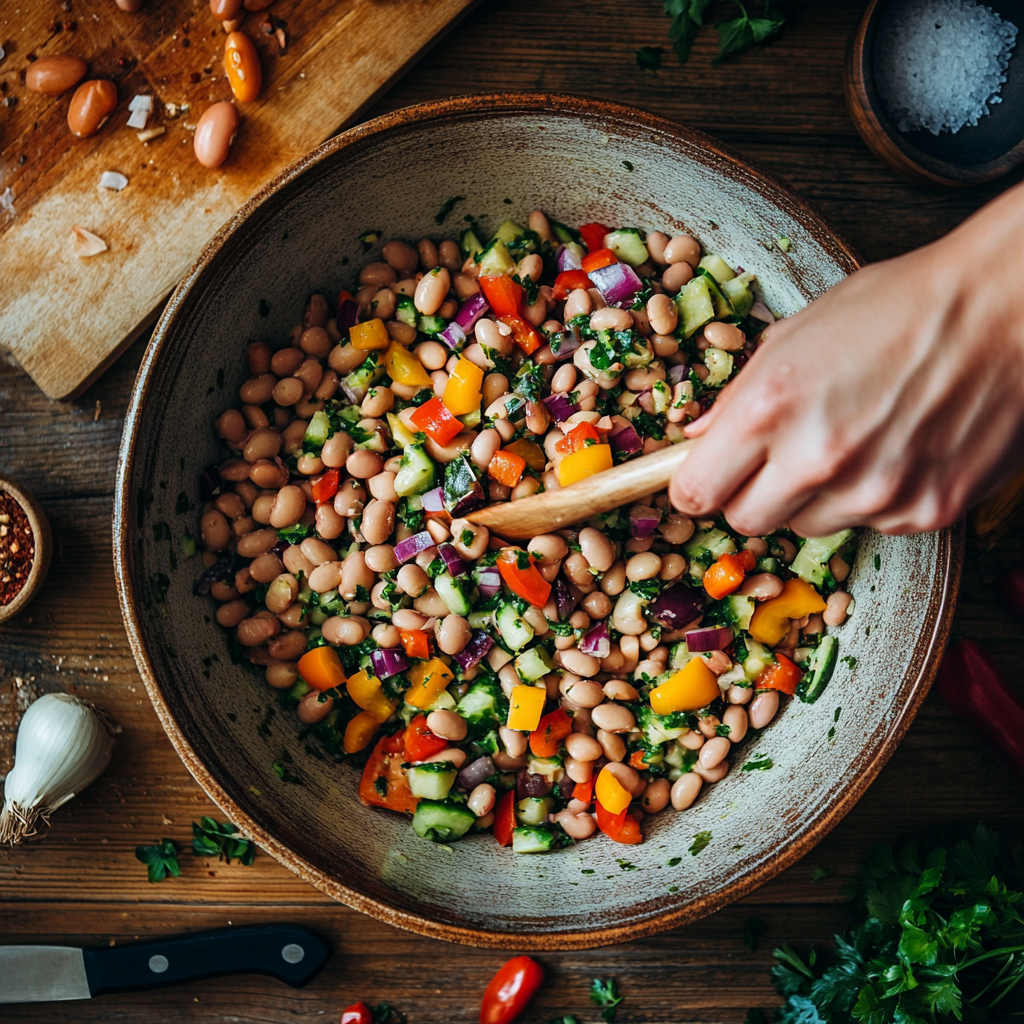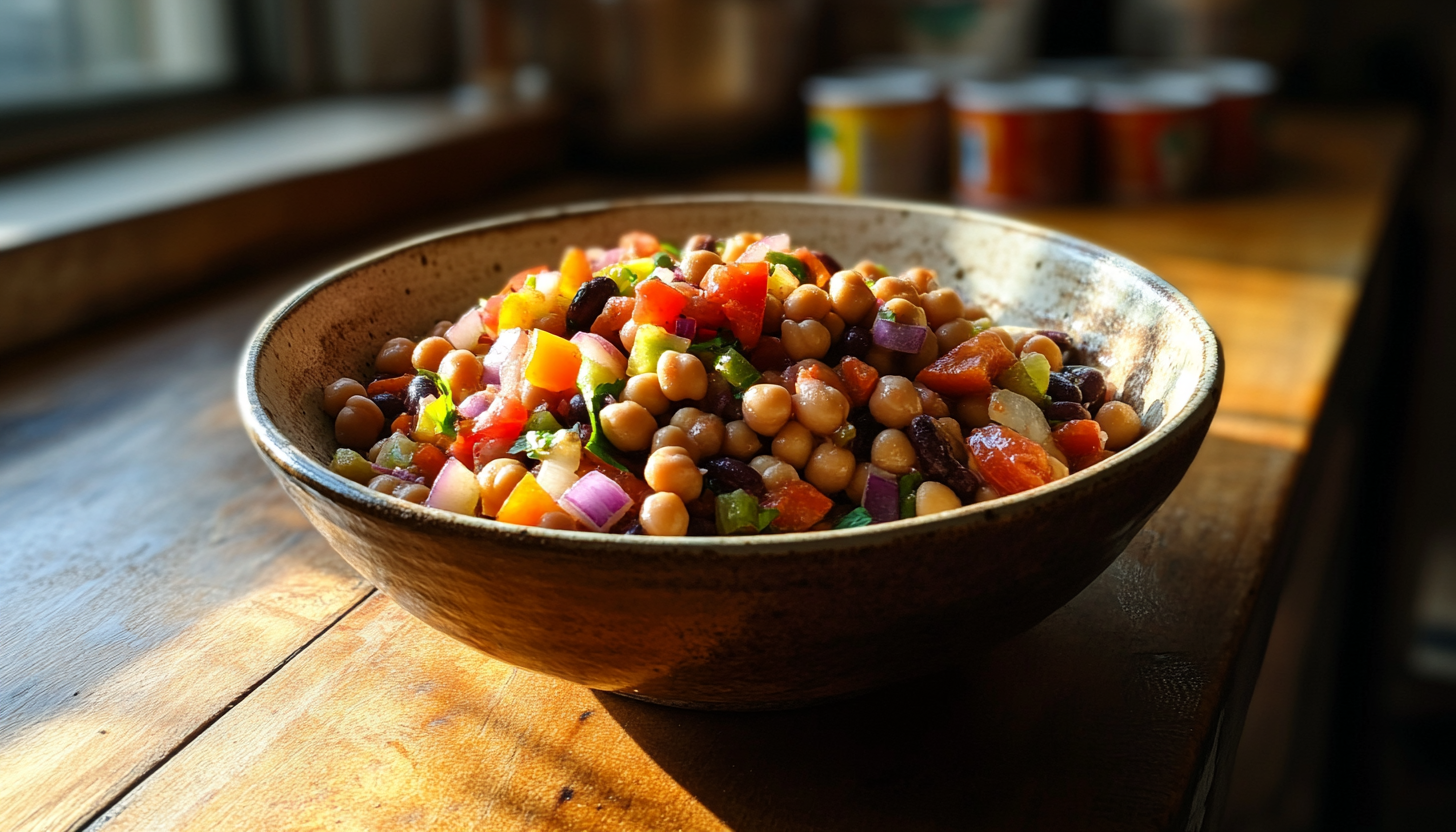Dense bean salad has emerged as a culinary sensation, combining the rich flavors of beans, fresh vegetables, and vibrant dressings. This hearty and nutrient-packed dish has captivated food enthusiasts worldwide, particularly through social media platforms like TikTok. Its versatility, simplicity, and health benefits make it a favorite for meal prep, family dinners, and casual gatherings. Packed with plant-based proteins and fibers, this salad not only satisfies hunger but also supports a balanced diet. Let’s delve into its origins, ingredients, and the reasons behind its growing popularity.
Key Takeaways:
| Feature | Details |
|---|---|
| Health Benefits | High in protein, fiber, and essential vitamins, supporting digestive and heart health. |
| Customization Options | Offers countless variations with beans, vegetables, and dressings. |
| Meal Prep Friendly | Easy to store and ideal for making in advance for weekly meals. |
Origins of Dense Bean Salad
The TikTok Influence
The dense bean salad trend gained momentum due to TikTok creators showcasing its simplicity and vibrant appeal. For example, content creator Violet Witchel demonstrated how to combine basic pantry staples like chickpeas and black beans with fresh veggies, inspiring millions to recreate the recipe. The visual nature of TikTok has made the salad a star in short, engaging videos, appealing to a health-conscious audience.
Not only is TikTok driving its popularity, but the platform also fosters innovation. From colorful Mediterranean-inspired versions to spicy, chipotle-infused takes, creators are constantly reinventing the dish. This exposure has transformed a humble salad into a must-try trend across age groups and dietary preferences.
Evolution from Traditional Bean Salads
Dense bean salad takes its roots from traditional recipes often found in Mediterranean, Latin American, and Middle Eastern cuisines. However, modern versions focus on maximizing nutritional density and visual appeal. Unlike conventional recipes that may prioritize beans alone, the dense bean salad balances beans with fresh vegetables, seeds, and protein-rich add-ins like feta cheese or tofu.
Its adaptability ensures it suits vegan, vegetarian, and omnivorous diets. The addition of global flavors, such as tahini dressings or chipotle seasonings, reflects a shift toward personalization and cultural fusion.
Tip: Add a tablespoon of olive oil and lemon juice to elevate the flavors and provide a dose of healthy fats.
Key Ingredients in Dense Bean Salad
Variety of Beans Used

The foundation of any dense bean salad is, of course, the beans. Common options include chickpeas, black beans, kidney beans, and cannellini beans. Each bean type offers unique textures and flavors, ensuring a diverse and enjoyable eating experience. For instance, black beans are known for their earthy taste, while chickpeas bring a subtle nutty flavor that pairs well with Mediterranean-style dressings.
Pro Tip: Use a mix of canned and fresh-cooked beans for the best flavor balance. Always rinse canned beans to remove excess sodium.
Fresh Vegetables and Add-ins
Dense bean salads shine because of their vibrant, fresh vegetable combinations. Popular choices include bell peppers, cucumbers, red onions, and cherry tomatoes. Adding extras like roasted corn or avocado slices can enhance both flavor and nutritional value. Additionally, including seeds or nuts such as sunflower seeds or slivered almonds provides a delightful crunch.
Here’s a quick list of must-have add-ins:
- Vegetables: Diced carrots, shredded kale, or spinach.
- Proteins: Hard-boiled eggs, grilled chicken, or tofu.
- Flavor Enhancers: Crumbled feta, fresh herbs like parsley, and lemon zest.
Nutritional Benefits of Dense Bean Salad
High Protein and Fiber Content
Dense bean salad is a powerhouse of nutrition, primarily due to its high protein and fiber content. Beans are renowned for being excellent plant-based protein sources, making this salad a great option for vegetarians and vegans. For instance, a serving of this salad can contain up to 15 grams of protein, depending on the ingredients used.
Fiber is another standout component, aiding in digestion and promoting satiety. This quality makes the salad perfect for those looking to maintain a healthy weight or regulate blood sugar levels. To learn more about the health benefits of dense bean salads, explore this resource.
Vitamins and Minerals
The fresh vegetables and beans in this salad are packed with essential vitamins and minerals. For example:
- Vitamin C: Found in bell peppers and tomatoes, it boosts immunity and supports skin health.
- Iron: Beans like lentils and black beans are excellent sources, combating fatigue and supporting oxygen transport in the body.
- Magnesium: Helps maintain healthy bones and regulate blood pressure.
This nutrient density underscores why dense bean salad is celebrated as a superfood meal.
Dense bean salad proves to be more than just a passing food trend. Its roots in traditional cuisine, combined with modern-day adaptability, make it a staple for health enthusiasts and foodies alike. Whether you’re drawn to its vibrant visuals, TikTok fame, or nutritional benefits, this salad is a versatile dish worthy of a permanent spot on your menu.
How to Prepare Dense Bean Salad
Step-by-Step Preparation Guide

Creating a dense bean salad at home is a straightforward process that requires minimal culinary skills. Begin by gathering your ingredients, which typically include canned or cooked beans, fresh vegetables, and a flavorful dressing. Rinse and drain the beans thoroughly to remove excess sodium and prepare the vegetables by chopping them into bite-sized pieces.
To assemble, combine the beans and vegetables in a large mixing bowl. Add your chosen dressing, which can range from a simple vinaigrette to a creamy tahini-based option. Mix gently to ensure the dressing evenly coats all ingredients without breaking down the beans. The key to a perfect dense bean salad lies in the balance of flavors and textures, so taste and adjust the seasoning as needed.
Steps at a Glance:
- Rinse and drain beans.
- Chop vegetables into bite-sized pieces.
- Combine beans and vegetables in a mixing bowl.
- Add dressing and mix gently.
- Adjust seasoning before serving.
Tips for Meal Prepping
Dense bean salad is an excellent choice for meal prepping, as it maintains its freshness for days when stored properly. To maximize its shelf life, refrigerate the salad in an airtight container. Layering ingredients, such as placing the dressing at the bottom and beans on top, can help prevent sogginess when storing for multiple days.
Moreover, dividing the salad into single-serving containers makes it convenient for grab-and-go meals. For those looking to switch up flavors during the week, consider storing the dressing separately and adding it just before eating. This ensures the ingredients retain their crispness and flavor.
Pro Tip: Use glass containers to keep the salad fresh and prevent any transfer of flavors or odors.
Variations of Dense Bean Salad
Mediterranean Style
For a Mediterranean twist, enhance your dense bean salad with ingredients like kalamata olives, crumbled feta cheese, and a lemon-olive oil dressing. This version often includes a mix of chickpeas and cannellini beans, paired with cucumbers, cherry tomatoes, and red onions for a vibrant, refreshing flavor. Fresh herbs like parsley or dill can elevate the dish, adding an aromatic finish.
Key Ingredients for Mediterranean Style:
- Chickpeas and cannellini beans
- Cucumbers, cherry tomatoes, and red onions
- Kalamata olives and crumbled feta
- Lemon-olive oil dressing with oregano
For more inspiration, check out these delicious dense bean salad recipes.
Spicy Chipotle Version
If you prefer a bold and smoky flavor, the spicy chipotle variation is a must-try. This version includes black beans, corn, and diced bell peppers, along with a chipotle-lime dressing that adds a spicy kick. You can also toss in roasted sweet potatoes or avocado slices for added creaminess and balance.
Ingredients to Include:
- Black beans and roasted corn
- Diced bell peppers and scallions
- Chipotle-lime dressing
- Optional add-ins: roasted sweet potatoes or avocado slices
This variation is perfect for those who enjoy a touch of heat in their meals while still prioritizing nutrition and flavor.
Serving Suggestions
Pairing with Main Dishes
Dense bean salad is incredibly versatile, making it an ideal side dish for various main courses. For example, it pairs beautifully with grilled chicken, baked salmon, or roasted vegetables. The robust flavors of the salad complement the savory notes of these proteins, creating a balanced and satisfying meal.
Suggested Pairings:
- Grilled Proteins: Chicken, shrimp, or tofu.
- Roasted Vegetables: Sweet potatoes, zucchini, or eggplant.
- Whole Grains: Quinoa, farro, or wild rice for added texture and nutrition.
Not only does it enhance the meal, but its nutrient profile also rounds out the dietary value of your plate.
Standalone Meal Options
Dense bean salad can also serve as a complete meal, thanks to its high protein and fiber content. Adding a handful of nuts, seeds, or a hard-boiled egg can further boost the nutritional value. This makes it a go-to option for lunchboxes, picnics, or quick dinners on busy evenings.
For individuals seeking plant-based meal ideas, this salad provides all essential nutrients while remaining easy to customize. Pair it with a whole-grain wrap or serve it atop a bed of greens for extra variety and flair.
“A dense bean salad is more than a side; it’s a satisfying, stand-alone meal that fuels your body with wholesome goodness.”
Dense bean salad’s adaptability, from meal prep to elegant serving ideas, proves its place as a staple in modern cuisine. Whether Mediterranean-inspired or boldly chipotle, this salad offers endless opportunities for customization, making it a true crowd-pleaser.
Common Mistakes to Avoid
Overmixing Ingredients
One of the most common errors when preparing dense bean salad is overmixing the ingredients. While it might seem necessary to thoroughly combine everything, overmixing can break down the beans, resulting in a mushy texture. This not only affects the salad’s appearance but also its overall enjoyment. To prevent this, gently fold the ingredients together using a wide spatula, ensuring the beans and vegetables remain intact.
Another tip is to add delicate ingredients, like avocado or feta cheese, at the very end. These can easily lose their shape and blend too much into the salad if mixed too vigorously.
Checklist to Avoid Overmixing:
- Use a gentle folding motion.
- Add soft ingredients at the end.
- Avoid using overly heavy dressings that can weigh down the salad.
Improper Storage Techniques
Improper storage can compromise the freshness and flavor of your dense bean salad. For instance, storing the salad in a non-airtight container can lead to a dry texture and loss of flavor. Similarly, keeping the dressing mixed in during storage can cause the salad to become soggy over time.
To maintain its quality, store the salad in a sealed container, and if possible, keep the dressing separate until ready to serve. When storing for more than two days, check the vegetables and beans for any signs of spoilage, as softer vegetables like tomatoes may release excess moisture.
Pro Tip: For salads with a high water content, such as those containing cucumbers or tomatoes, pat the vegetables dry before mixing them in. This simple step ensures the salad retains its desired texture longer.
Health Considerations
Managing Caloric Intake
Dense bean salad is undoubtedly healthy, but portion control is key for those monitoring their caloric intake. Beans are naturally calorie-dense, and the addition of dressings, cheeses, or nuts can quickly increase the salad’s overall calorie count. Opting for lighter dressings or using fresh herbs and lemon juice as flavor enhancers can help keep the salad light without sacrificing taste.
Moreover, choosing low-sodium beans or rinsing canned beans can significantly reduce the dish’s sodium content, which is crucial for heart health. Keeping an eye on these elements ensures the salad remains a guilt-free indulgence.
Calorie-Friendly Ingredients:
- Substitute cheese with nutritional yeast for a savory touch.
- Use Greek yogurt-based dressings instead of mayonnaise or cream.
- Incorporate water-rich vegetables like cucumbers and celery.
Addressing Digestive Concerns
Beans, while highly nutritious, can sometimes lead to digestive discomfort due to their fiber content and the presence of oligosaccharides. To minimize this, start with smaller portions if you’re not accustomed to a high-fiber diet. Soaking and thoroughly rinsing beans can also help reduce these compounds, making them easier to digest.
Adding digestive-friendly herbs like mint or ginger to the salad can further aid in alleviating potential bloating. This not only enhances the salad’s flavor but also ensures a more enjoyable dining experience.
“A few simple adjustments can make dense bean salad a delicious and digestible meal for everyone.”
FAQs About Dense Bean Salad
How Long Does Dense Bean Salad Last in the Fridge?
When stored correctly in an airtight container, dense bean salad can last 3-5 days in the fridge. However, salads with delicate ingredients like avocado or tomatoes may only stay fresh for 2-3 days. Keeping the dressing separate can extend the salad’s shelf life.
Can I Freeze Dense Bean Salad?
Freezing dense bean salad is not recommended as it can alter the texture of the beans and vegetables. Upon thawing, the salad may become mushy and lose its vibrant taste. For meal prepping, it’s better to freeze individual ingredients, like cooked beans, and assemble the salad fresh when needed.
What Beans Work Best for Dense Bean Salad?
Chickpeas, black beans, and kidney beans are popular choices for their firm texture and rich flavor. Mixing different beans not only adds variety but also enhances the salad’s nutrient profile.
Is Dense Bean Salad Suitable for Vegans?
Yes, dense bean salad is naturally vegan if you omit animal-based ingredients like cheese. Substitutes like vegan feta or nutritional yeast can provide similar flavors without compromising dietary preferences.
How Can I Reduce the Sodium Content?
Using low-sodium canned beans and limiting added salts in the dressing are effective ways to reduce sodium. Additionally, fresh herbs and spices can enhance flavor without the need for extra salt.
Final Thoughts on Dense Bean Salad
Dense bean salad exemplifies the perfect blend of health, flavor, and convenience. Its versatility makes it suitable for a variety of occasions, from quick weekday lunches to impressive dinner party sides. By avoiding common mistakes, managing health considerations, and experimenting with flavors, you can make this dish a regular feature in your culinary repertoire.
Not only is it easy to prepare, but it also caters to diverse dietary needs, ensuring everyone can enjoy its benefits. Try your own version of dense bean salad today, and discover why it has become a beloved staple in kitchens worldwide. Share your creations and inspire others to embrace this nutrient-packed dish!
“Prepare your own dense bean salad and experience a delightful, wholesome meal that fits your lifestyle perfectly!”

